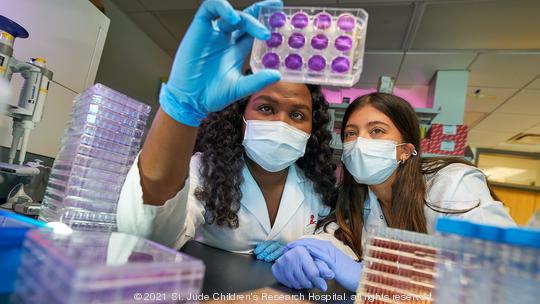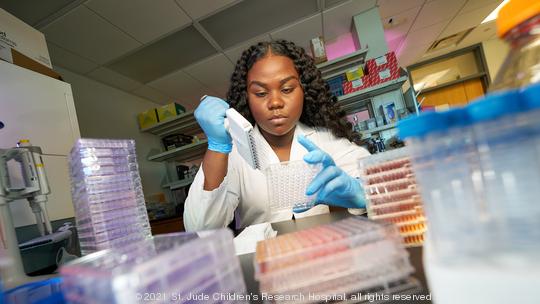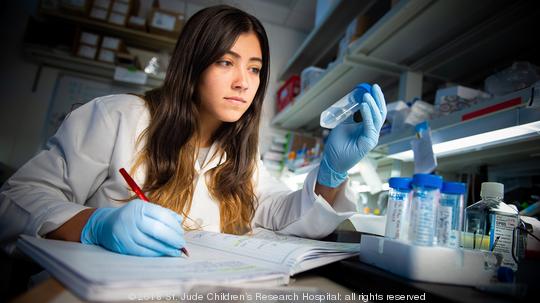
Maria Smith grew up on the Commonwealth of Dominica, a Caribbean Island country with a population of around 72,000 and a land area roughly the size of Memphis.
To this day, it remains close to her heart. But growing up, opportunities for students passionate about science and medicine were rare. Her only exposure to research was a week of shadowing at a local hospital, and her interests went beyond this — she wanted to study tropical diseases, and how they affected Caribbean populations.
“That opened my eyes to seeing the lack of resources we have and the lack of opportunities for younger students,” she said.
About 400 miles away, Ana Vazquez-Pagan was raised in Puerto Rico, where, like Smith, she realized that satisfying her hunger for research could mean leaving home. As an eighth grader in 2009, she had seen how the H1N1 influenza pandemic had affected her home country. And she wanted to study virus pathogenesis, in-depth.
“Growing up, you realize you’re sort of in this bubble,” Vazquez-Pagan said. “And there’s so much more to learn.”
Separate, but similar, goals for Smith and Vazquez-Pagan have led them to the St. Jude Graduate School of Biomedical Sciences at St. Jude Children’s Research Hospital. They came to the institution as doctoral candidates after graduating from the Rochester Institute of Technology in New York and Northeastern University in Boston in 2018, respectively.
Currently, they’re working in the infectious diseases lab of Stacey Schultz-Cherry, Ph.D., where they’re studying why certain high-risk populations are more susceptible to the flu. Smith is studying the flu in those with obesity, Vazquez-Pagan in pregnant women.

“[Smith and Vazquez-Pagan] are the future of science, especially infectious diseases,” said Schultz-Cherry, who's also the associate dean of student affairs at the graduate school. “Their projects are incredibly innovative and very unique things they developed themselves, outside of what we know.”
Here’s a breakdown of the research they’re doing — and why it’s important.
Smith’s research
“Let’s start with influenza infections in general,” Smith told MBJ as she described her research.
Typically, influenza viruses target epithelial cells on the lower respiratory tract, and on these epithelial cells is a protein called Beta 6 integrin, which can heighten risk for infection and severe cases, serving, in some ways, as a beacon for viruses.
“Let’s say you have a virus get in your nose, or throat; you inhale it,” Schultz-Cherry said. “And what this little integrin does … it becomes like a big red flag on the cell waving at the virus — ‘Hey, come on over here and infect me, because I’m going to be welcoming to you.’”
But why is this relevant to obese populations?
Because, Smith explained, studies have shown that, just in their normal state, obese people have shown high levels of this Beta 6 integrin.

“That’s the problem, those populations are more likely to get infected,” Schultz-Cherry added. “They have a lot of red flags on their cells.”
And Beta 6 integrin doesn’t just help viruses find the cells — they also make the cells a more hospitable environment for them.
So, Smith is working to better understand this process, to hopefully help mitigate its effects. If she can confirm the theories about Beta 6 integrin and how they’re affecting obese populations, it could be made a therapeutic factor for influenza patients, and potentially be used to supplement flu vaccines.
The treatment would ideally reduce the levels of Beta 6 integrin in people, thereby hopefully boosting their immune systems, and lowering chances of infection and severe cases. Already, a model developed in the lab shows that when the integrin is absent, people have significantly higher survival outcomes, and don’t lose as much weight. Weight loss can be an indicator of how susceptible they are to infection.
Exactly when all this could come to fruition isn’t clear. Smith noted that there can be unpredictability in the research. But Schultz-Cherry believes it could be sooner than you think — especially with anti-integrin drugs for other purposes already in clinical trials.
Vazquez-Pagan's research
When Vazquez-Pagan first started working in Schultz-Cherry’s lab, she discovered a paper from 1918 that showed the devastating effects the 1918 flu pandemic had on pregnant women. They were more prone to infection and severe illness.
These days, they’re still believed to be more susceptible to influenza viruses. And Vazquez-Pagan wants to help the world gain a better understanding of this.
“Over a 100 years later, we still say they’re higher risk,” she said. “But why?”
Learning from the model systems Smith has worked with focused on obesity, Vazquez-Pagan has created a model to help scientists understand the increased severity of the flu in pregnant women. And she’s not just interested in learning about what’s broadly happening with the flu during the entire nine months — but rather, in the different stages of the pregnancy term.
“It’s always generally put out there as this one whole thing that happens, but at the end of the day, there are many different stages that occur during pregnancy, different trimesters,” she said. “And there are many things happening physiologically.”
She’s also focused on the lung compartments, and how they could change throughout the pregnancy to accommodate the growing fetus, as it needs some of the mother’s oxygen nutrients.

Those changes, Vazquez-Pagan explained, could affect responses to respiratory infections like the flu — which can impact not just the mother, but the fetus.
“I am trying to understand, with model systems I’ve developed, the ‘why,’” she said. “What is it about the lung at this time, especially early in pregnancy, where all of those things are still being established? If you get infected when the placenta is not fully established, or the baby is still so young, that’s when you have adverse fetal outcomes that could also occur.”
The hope is that her research can lead to more effective therapeutic applications and treatments for pregnant women.
“If I can better understand, 'Okay, this is happening in the lung, what is going to be the best way to protect the mom from this happening?'” she said. “We’re trying to look at different platforms that may be able to protect mom better and protect the baby better.”
Next steps
While Smith and Vazquez-Pagan are far from their native countries, their homelands aren’t far from their minds. Vazquez-Pagan’s experiences in Puerto Rico have aided her in her work, just as her experiences at St. Jude will help her going forward.
“I do have the perspective of home, how things are done there, and that’s very valuable,” she said. “Now I have the opportunity to be here, to learn from people at St. Jude, and take that knowledge, and go to whatever my next step will be. … That way I’ll continue going up that ladder, where I can go back and look down and help everyone climb it up with me.”
And Smith, for her part, wants to one day work with high school teachers in the Commonwealth of Dominica, to help improve the curriculum there — so students can get the opportunities she didn’t have.
“I want to improve resources at the educational level,” she said. “My home is close and dear to my heart."









